Symptoms
The newest leaves of manganese (Mn)-deficient palms emerge chlorotic with longitudinal necrotic streaks (Figure 1 and Figure 2). As the deficiency progresses, newly emerging leaflets appear necrotic and withered on all but basal portions of the leaflets. This withering results in a curling of the leaflets about the rachis giving the leaf a frizzled appearance ("frizzletop") (Figure 3, Figure 4, Figure 5, and Figure 6). Within a single leaf, Mn deficiency symptoms are concentrated at the base of the leaf and are less severe or nonexistent towards the tip (Figure 7). On new leaves of Mn-deficient Cocos nucifera (coconut palm), necrotic leaflet tips fall off and the leaf has a singed appearance (Figure 8). In severely Mn-deficient palms, growth stops and newly emerging leaves consist solely of necrotic petiole stubs (Figure 9). Palm death usually follows. Although the symptoms described above develop only on newly expanding leaves, the presence of symptomatic leaves lower in the canopy is an indication that Mn deficiency has occurred in the past.
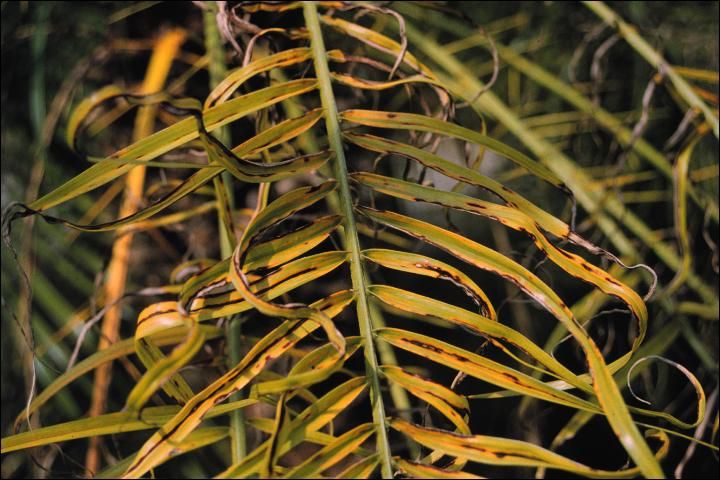
Credit: T. K. Broschat, UF/IFAS
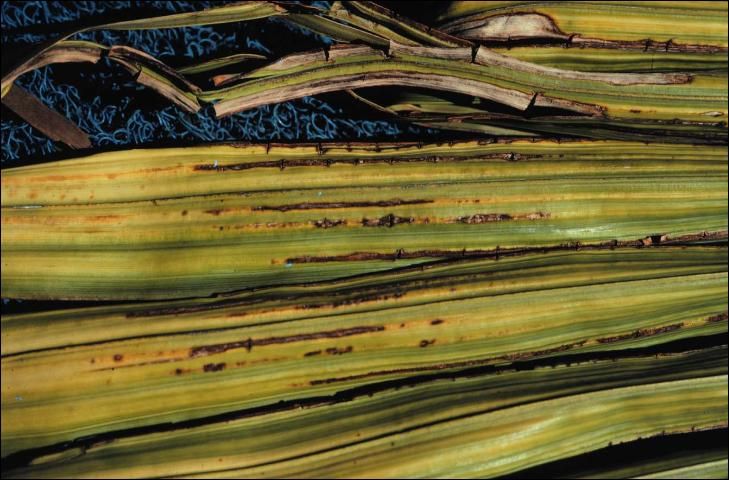
Credit: T. K. Broschat, UF/IFAS
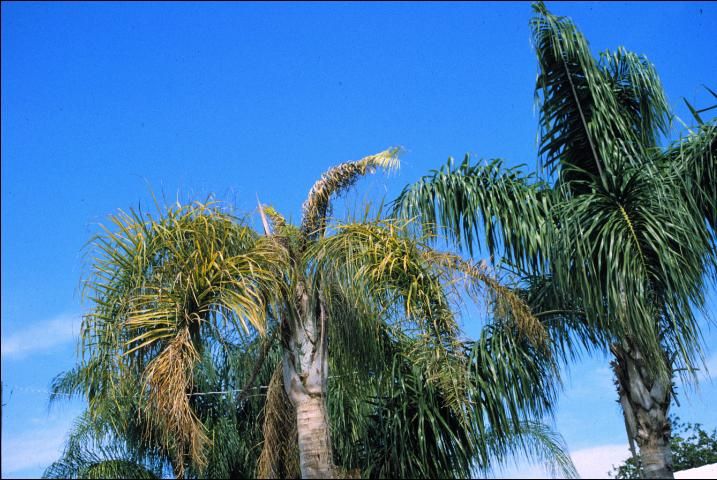
Credit: T. K. Broschat, UF/IFAS
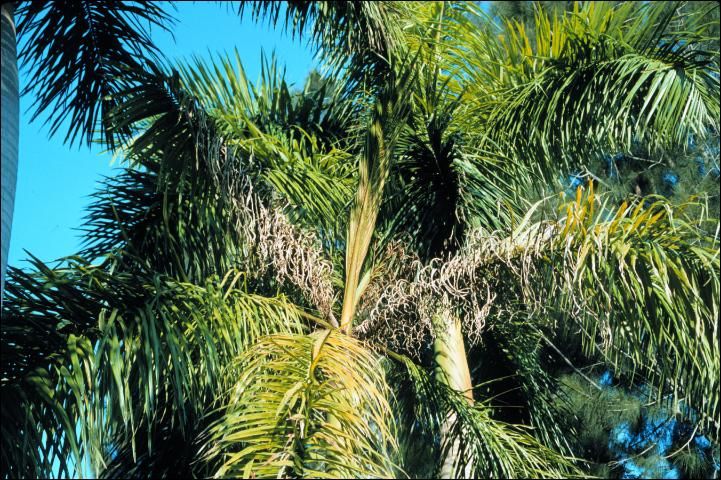
Credit: T. K. Broschat, UF/IFAS
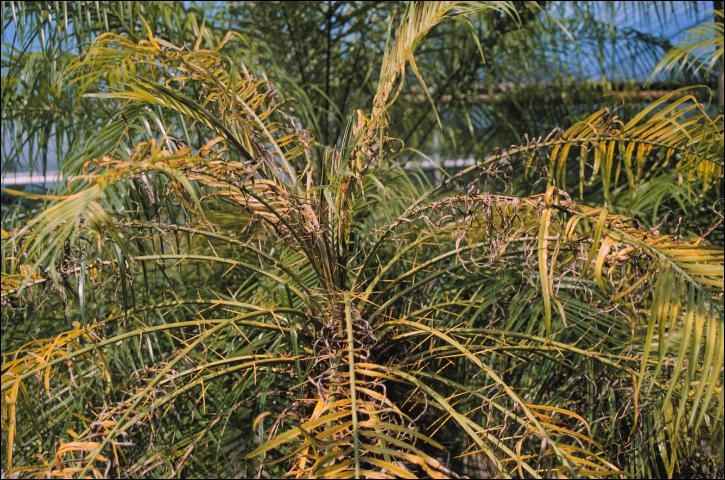
Credit: T. K. Broschat, UF/IFAS
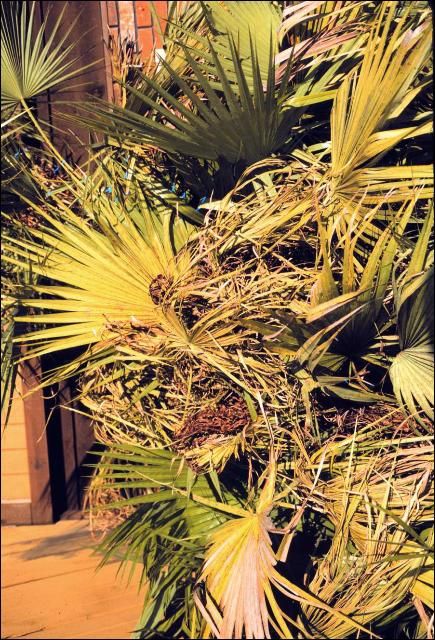
Credit: T. K. Broschat, UF/IFAS
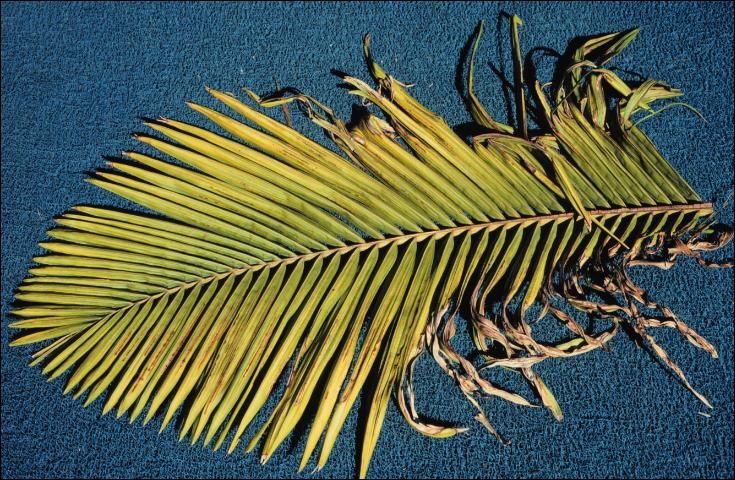
Credit: T. K. Broschat, UF/IFAS
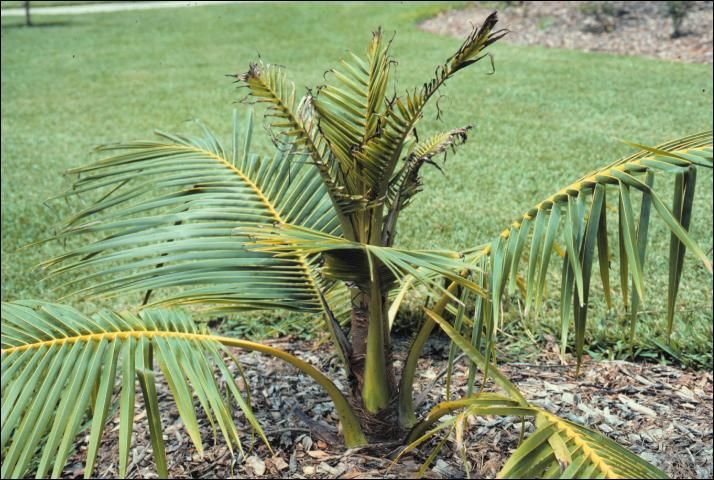
Credit: T. K. Broschat, UF/IFAS
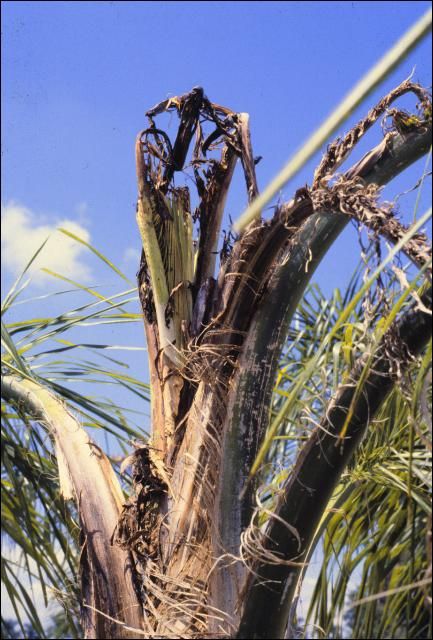
Credit: T. K. Broschat, UF/IFAS
Cause
Manganese deficiency is caused by insufficient Mn in the soil or by high soil pH, which greatly reduces Mn availability (Figure 3). In soils where Mn is marginally sufficient, cold soil temperatures may cause temporary Mn deficiency by reducing root activity levels. This is particularly common on Cocos nucifera in Florida. Composted sewage sludge and manure products have also been shown to strongly bind Mn when used as fertilizers or as soil amendments for palms (Figure 8).
Occurrence
Manganese deficiency is very common on alkaline soils, but can occur in containers if drainage is poor or soil temperatures are cool. Most species of palms can be affected, but Syagrus romanzoffiana (queen palm), Roystonea regia, (royal palm), Acoelorrhaphe wrightii (paurotis palm), Phoenix roebelenii (pygmy date palm), and Elaeis guineensis (African oil palm) are particularly susceptible.
Diagnostic Techniques
Visual symptoms may be sufficient to diagnose this disorder, but leaf nutrient analysis is also suggested, since symptoms of boron (B) deficiency can be similar. Late stage potassium (K) deficiency symptoms are virtually indistinguishable from those of Mn deficiency at a distance and close examination is required to look for characteristic longitudinal streaking and basal (vs distal) symptom distribution of Mn deficiency.
When sampling for leaf analysis, select 4 to 6 central leaflets from the youngest fully-expanded leaf. Soil analysis is not particularly useful for diagnosing palm nutrient deficiencies, since palm nutrient symptomology often bears little resemblance to soil nutrient profiles.
Management
Fertilizers containing water soluble Mn should be used routinely on soils where Mn deficiency is a problem. Although soil applications of manganese sulfate are effective, spraying the foliage with this product may achieve more rapid, though short-term results, especially on alkaline soils. This should be considered as a supplement to soil applications, not as a replacement. Manganese sulfate solutions to be applied to the foliage can be made by mixing 3 lbs of this product in 100 gals of water. Soil application rates are dependent on palm species, soil type, and severity of Mn deficiency. These rates will range from as low as 8 oz for a small palm or one growing on an acid sand soil to 8 lbs for a large palm growing on a limestone soil. Broadcast this product over the soil under the palm canopy. Applications can be repeated every 2 to 3 months, depending on the severity of the problem and soil type. However, a response may not be seen until 3 to 6 months after applications. Avoid using composted sewage sludge or manure products near palms. Excessive Mn applications normally result in an induced Fe deficiency, with its characteristic new leaf chlorosis.
Selected References
Broschat, T.K. 1984. Nutrient deficiency symptoms in five species of palms grown as foliage plants. Principes 28:6–14.
Broschat, T.K. 1991a. Manganese binding by municipal waste composts used as potting media. J. Environ. Hort. 9:97–100. https://doi.org/10.24266/0738-2898-9.2.97
Broschat, T.K. 1991b. Effects of manganese source on manganese uptake by pygmy date palms. HortScience 26:1389–1391. https://doi.org/10.21273/HORTSCI.26.11.1389
Bull, R.A. 1961. Studies on the deficiency diseases of the oil palm. 3. Micronutrient deficiency symptoms in oil palm seedlings grown in sand culture. J. West African Inst. Oil Palm Res. 3:265–272.